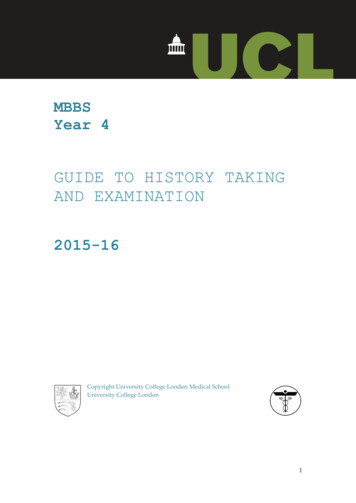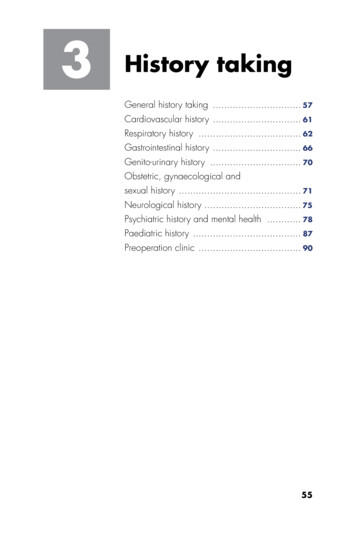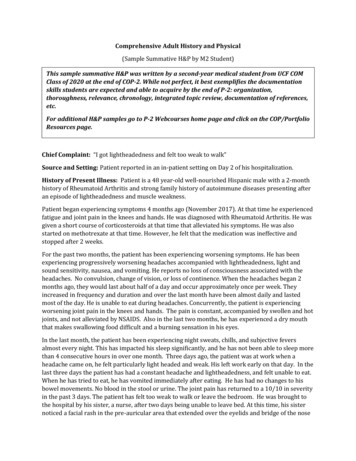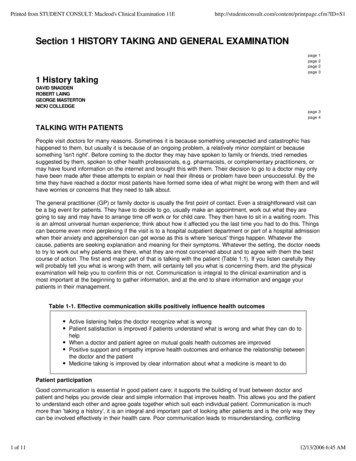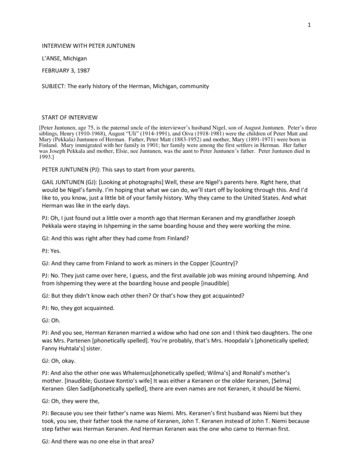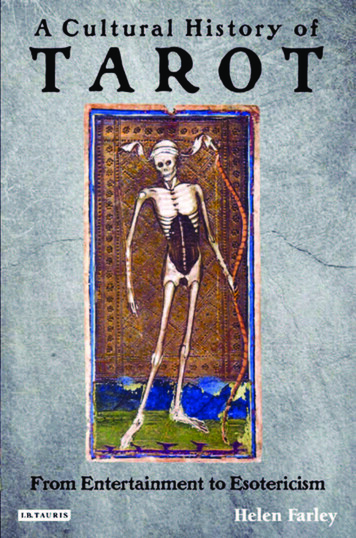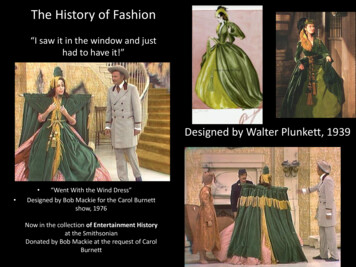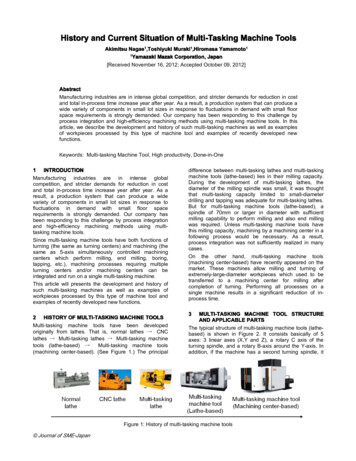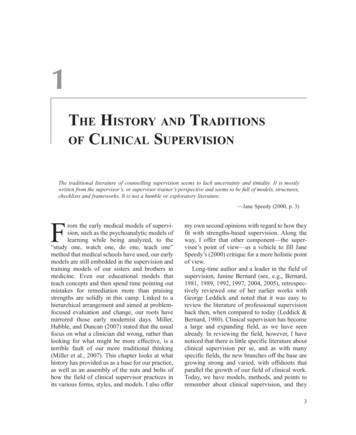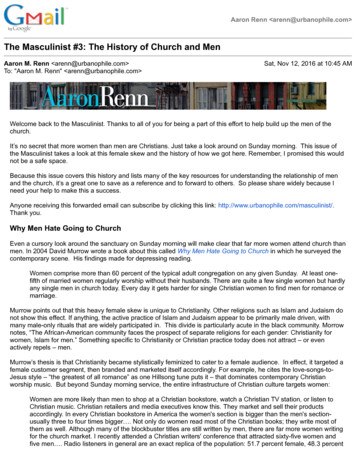
Transcription
Aaron Renn arenn@urbanophile.com The Masculinist #3: The History of Church and MenAaron M. Renn arenn@urbanophile.com To: "Aaron M. Renn" arenn@urbanophile.com Sat, Nov 12, 2016 at 10:45 AMWelcome back to the Masculinist. Thanks to all of you for being a part of this effort to help build up the men of thechurch.It’s no secret that more women than men are Christians. Just take a look around on Sunday morning. This issue ofthe Masculinist takes a look at this female skew and the history of how we got here. Remember, I promised this wouldnot be a safe space.Because this issue covers this history and lists many of the key resources for understanding the relationship of menand the church, it’s a great one to save as a reference and to forward to others. So please share widely because Ineed your help to make this a success.Anyone receiving this forwarded email can subscribe by clicking this link: http://www.urbanophile.com/masculinist/.Thank you.Why Men Hate Going to ChurchEven a cursory look around the sanctuary on Sunday morning will make clear that far more women attend church thanmen. In 2004 David Murrow wrote a book about this called Why Men Hate Going to Church in which he surveyed thecontemporary scene. His findings made for depressing reading.Women comprise more than 60 percent of the typical adult congregation on any given Sunday. At least onefifth of married women regularly worship without their husbands. There are quite a few single women but hardlyany single men in church today. Every day it gets harder for single Christian women to find men for romance ormarriage.Murrow points out that this heavy female skew is unique to Christianity. Other religions such as Islam and Judaism donot show this effect. If anything, the active practice of Islam and Judaism appear to be primarily male driven, withmany male-only rituals that are widely participated in. This divide is particularly acute in the black community. Morrownotes, “The African-American community faces the prospect of separate religions for each gender: Christianity forwomen, Islam for men.” Something specific to Christianity or Christian practice today does not attract – or evenactively repels – men.Murrow’s thesis is that Christianity became stylistically feminized to cater to a female audience. In effect, it targeted afemale customer segment, then branded and marketed itself accordingly. For example, he cites the love-songs-toJesus style – “the greatest of all romance” as one Hillsong tune puts it – that dominates contemporary Christianworship music. But beyond Sunday morning service, the entire infrastructure of Christian culture targets women:Women are more likely than men to shop at a Christian bookstore, watch a Christian TV station, or listen toChristian music. Christian retailers and media executives know this. They market and sell their productsaccordingly. In every Christian bookstore in America the women's section is bigger than the men's sectionusually three to four times bigger . Not only do women read most of the Christian books; they write most ofthem as well. Although many of the blockbuster titles are still written by men, there are far more women writingfor the church market. I recently attended a Christian writers' conference that attracted sixty-five women andfive men . Radio listeners in general are an exact replica of the population: 51.7 percent female, 48.3 percent
male. But Christian AC radio (the format playing on most contemporary Christian music stations today) drawsan audience that's 63 percent female and 37 percent male. Christian stations garner, on average, 21 percentmore women listeners than mainstream stations . K-Love, America's largest syndicated Christian music radioservice, with affiliates in 189 cities and towns, 12 targets its programming at eighteen- to forty-five-year-oldwomen.He even implies this has bled into theology. He notes creating two columns of characteristics and asking people whichone best represented Christ. These weren’t biblically derived lists but were instead compilations of masculine andfeminine traits taken from the book Men Are from Mars, Women Are from Venus. People overwhelmingly said the listof feminine characteristics best described Christ.The Roots of the Feminization of ChristianityMurrow is writing a typical popular audience book that derives most of its thinking from present day church culturetrends and uses a business school style of analysis. Leon Podles, who has a Ph.D, from the University of Virginia,took a more scholarly approach to the question in his 1999 book The Church Impotent: The Feminization ofChristianity (free to read online in PDF format).Podles agrees with Murrow on the state of current Christianity, but adds some new dimensions. First, he argues thatthis female skew is specific to Western Christianity, saying that it has not affected the Eastern Orthodox Church. (I’mnot convinced this is accurate). Secondly, he points out that this female skew is not new, but in fact goes backhundreds of years to the High Middle Ages.Starting in the 12th and 13th century, Podles says Western Christianity underwent a culture change that feminized it.He advances three main key driving causes, the popularization of “bridal mysticism” by St. Bernard of Clairvaux, awomen’s movement in the church, and Scholasticism.Bridal mysticism involved the use of highly erotic language to represent the individual believer as the bride of Christ,inspired by the Song of Solomon:The use of erotic language to describe the relation of the believer to God was not unprecedented, but Bernard,for reasons that will become clear, did not choose to acknowledge his intellectual debts. Bernard claimed that“if a love relationship is the special and outstanding characteristic of bride and groom it is not unfitting to callthe soul that loves God a bride.” Having established the principle for the use of such language, Bernard thenelaborated. He referred to himself as “a woman” and advised his monks to be “mothers”—to “let your bosomsexpand with milk, not swell with passion”—to emphasize their paradoxical status and worldly weakness.The women’s movement was a large 13th century increase in the number of women flowing into religious orders,possibly resulting from a gender imbalance caused by an unusually high number of male deaths, and increasingfreedom of travel for women due to widespread peace. The monasteries initially resisted having to instruct women inreligious orders, but ultimately capitulated, in part because of Papal directives.Scholasticism was a medieval intellectual movement that merged theology with classical philosophy, especiallyAristotle. Thomas Aquinas is the paragon of the Scholastic type. Podles says that prior to Scholasticism, theology wasthe province of the monastery, where theological study was merged with religious practice as part of masculine dailydevotional life. In the university, the home of the Scholastics, theology was a detached, rationalistic endeavor. TheScholastics may have been personally devout or even monks themselves, but their intellectual endeavors were in a“scientific” mode. Their work also resurrected Aristotelian notions about women that they interpreted as makingwomen superior as to grace.All of these threads continued to develop over time in ways that, per Podles, divorced Christianity from masculinityand attached it more and more to femininity and thus drove a female skew in church attendance.Podles also points out that the men Christianity does attract are disproportionately low-masculinity “nice guy” types:Because Christianity is now seen as a part of the sphere of life proper to women rather than to men, itsometimes attracts men whose own masculinity is somewhat doubtful. By this I do not mean homosexuals,although a certain type of homosexual is included. Rather religion is seen as a safe field, a refuge from thechallenges of life, and therefore attracts men who are fearful of making the break with the secure world ofchildhood dominated by women. These are men who have problems following the path of masculine
development.Those attracted into the ministry were even more feminized, with academic research finding both Catholic andProtestant ministers rated as extremely feminine in contrast with other men.I should point out that First Things ran a critical review of the book when it came out. I have some issues with thisreview, but it’s important to engage with critics. The upshot is that basically everyone agrees the church was skewedfemale in its attendance and orientation long before the modern day, though there’s debate about exactly when andwhy this started.The Church Turns Anti-Male Circa 1800A further shift occurred at the dawn of the 19th century when the church embraced a worldview that portrayed womenas embodying holiness and men as embodying sin. That is, the church increasingly came to have both an extremelynegative view of masculinity and men and to uphold women and femininity as, in their natural state, exemplars andbearers of virtue.The is perhaps best illustrated by Callum Brown’s 2009 book The Death of Christian Britain. Brown is a professor ofhistory at the University of Strathclyde. His book is about the decline of Christianity in the UK but is also applicable toAmerica to which Britain was culturally linked. Before getting to Brown himself, it’s worth citing an endorsement of hiswork from no less than Charles Taylor, the Canadian philosopher whose mammoth A Secular Age was a landmarkand highly influential work. Taylor endorses Brown’s take on the sexes in A Secular Age, saying:Callum Brown here even speaks of a “demonization” of male qualities, and a “feminization of piety.” . AsCallum Brown has shown for the evangelical case, the ethical stance was predicated on the idea of women aswanting a stable family life, which was constantly endangered by male temptation, to drink, to gambling, toinfidelity. And we see similar ideas propounded on the Catholic side . We connect up here with a profounddevelopment, evidence across the confessional divide over the two or three centuries, which as been called the“feminization” of Christianity, about which Callum Brown speaks in his interesting recent book. It obviously hassomething to do with the close symbiosis established between Christian faith and the ethic of “family values”and disciplined work, which has downgraded if not been directed against military and combative modes of life,as well as forms of male sociability: drinking, gambling, sport, which took them outside the arenas of both workand home.It’s particularly notable to see Taylor cite Brown in this regard given that these two men have radically different andincompatible takes on secularization.As Taylor says, Callum Brown documents, through an extensive review of Christian literature, that around 1800Christianity shifted from viewing piety as a primarily male mode of life to a primarily female one. Men and masculinitycame to be perceived as acute threats to holiness. (Brown’s secularization thesis is that the merger of femininity withChristianity was so complete that when women ceased to unify their Christian and feminine identities around 1960,Christianity suffered a sudden and catastrophic collapse).Some excerpts from Brown’s book:After 1800, the religiosity of women was paramount to the evangelical scheme for moral revolution. They wereregarded as having special qualities which placed them at the fulcrum of family sanctity. Though the female evangelical narrative structure might vary in these ways, there were uniform characteristics.First, women’s conversions were usually taken for granted; the issue was their ability to choose a godlyhusband or reform an ungodly one. Second, women’s spiritual destiny was virtually never portrayed as a battlewith temptation or real sin; fallen women did not appear as central characters, and none of the usualtemptations like drink or gambling ever seemed to be an issue with them. The problem is the man, sometimesthe father, but more commonly the boyfriend, fiancé, or husband, who is a drinker, a gambler, keeps the ‘badcompany’ of ‘rough lads’ and is commonly a womanizer. The man is the agency of the virtuous woman’sdownfall; he does not make her bad, but does make her suffer and poor. She is not always portrayed as havingundergone a major conversion experience, but to have emerged from childhood into a disciplined and natural‘goodness.’ The British Weekly series reflected the view that at the heart of urban society, the problems of social order,
crime, immorality, and irreligion were interconnected products of male weakness. This weakness wasintrinsically rooted in maleness, a heathen ‘other’ located at sites of temptation. In evangelical stories about piety, women appeared throughout as good but not always converted; men, bycontrast, almost always appeared as in a perilous sinful state until near the end. Men were the problem, givenmanifold temptations: drink (nearly always), gambling (increasingly after 1890), and ‘rough’ in overall culturalterms. They lived dissipated lives which caused suffering and ruination to mothers, wives, and children.Nowhere did evangelical literature have such a powerful influence in the public domain, including in ‘secular’fiction, as in its demonization of men. [emphasis added] A large proportion of evangelical stories of men centered on the destruction of families by male evils. In the evangelical and temperance movements, women were both the moral guardians and the moral victims offathers, brothers, husbands, and sons.This is pretty clear, but to summarize simply: the church came to see women as naturally good and men as naturallyevil and the source of most problems in the world. Again, I stress that these observations from Brown are based onan extensive examination of evangelical literature itself – not from secular or anti-Christian sources.Is it any wonder the church skewed so heavily female?The Church’s View of Men TodaySo how does the church view men and women today? Asanyone with even a cursory knowledge of the contemporarychurch can tell you, it’s easy to see what Brown documentedabout the 19th century is still in play, updated to modern times.To pick but one example, consider a recent Christian book byCarolyn Curtis James called Malestrom [sic]. James is aconsultant for the major Christian publisher Zondervan and wasnamed a top 50 evangelical woman to watch by ChristianityToday magazine. This book is basically claims most of thetragedies of world history are the fault of men. As she says:The malestrom is the particular ways in which the fall impactsthe male of the human species — causing a man to losehimself, his identity and purpose as a man, and above all tolose sight of God’s original vision for his sons. Therepercussions of such devastating personal losses are not merely disastrous for the men themselves, butcatastrophic globally This is the history of the planet in microcosm — men killing others.James appears to be a fairly liberal Christian, but conservatives feel exactly the same if not more so. A recent FirstThings article by Glenn Stanton of Focus on the Family is illustrative. Titled “Men and Women Are Not Equal,” theheadline teases us with an expectation of a defense of patriarchy or some such notion. But Stanton is just playinggames. Here’s what he really thinks:Women create, shape, and maintain human culture. Manners exist because women exist. Worthy men adjusttheir behavior when a woman enters the room. They become better creatures. Civilization arises and enduresbecause women have expectations of themselves and of those around them . Anthropologists have longrecognized that the most fundamental social problem every community must solve is the unattached male. Ifhis sexual, physical, and emotional energies are not governed and directed in a pro-social, domesticatedmanner, he will become the village’s most malignant cancer. Wives and children, in that order, are the onlysuccessful remedy ever found . This is why Golding’s Lord of the Flies is a tale not so much about the darknature of humanity as about the isolation of the masculine from the feminine. Had there been just a fewconfident girls amongst those boys, its conclusion might have been more Swiss Family Robinson Man andwoman are not equal. He owes what he is to her. That is hardly her only power, but it is among her mostformidable. Christianity has always known this. The Savior of the world chose to come to us through a wife andmother.
This is identical to what Brown identified as the Christian attitude of the 19th century. Women are the natural civilizers,men the great despoilers of society.Popular conservative pastors sometimes brutalize men from their pulpits. As just one example, consider MattChandler, the A-list pastor of Dallas area megachurch the Village Church and head of the Acts 29 network. In onesermon – ostensibly devoted to women’s sins, believe it or not – Chandler prays this almost imprecatory prayer:Father, for men in this room who prey on insecure women with wounded hearts, Father, I just pray over thesemen a type of weight on their souls that would be crushing. Father, I thank you that you do not take lightlywolves hunting down your daughters and that there would be a day that these men, hollow-chested boys ingrown up bodies will cry out as you come for mountains to fall and that the mountains will flee before yourcoming. I thank you that you are a just judge who will not handle lightly boys who can shave who takeadvantage of your daughters. I pray that there might be repentance for these men for the salvation of their ownsoul.It’s worth contrasting Chandler’s treatment of male and female sexual sin. Just watch his famous “Jesus wants therose” clip in which Chandler is personally babysitting for a single mother who is actively having an affair with a marriedman and becomes indignant when another pastor calls out sexual sin in this woman’s presence - not her specific sin,mind you, but sexual sin generally.Chandler’s style may be tough on men, but even the most moderate in tone and intellectually sophisticatedconservative pastors have a similarly skewed negative few of men. To be clear, many of these men have greatministries in many ways – including Chandler. But I’ve reviewed many books and sermons from many big nameChristian pastors and writers, and they to a man fall into a similar pattern to one degree or another. The femalewriters and speakers are if anything even more extreme (cf James).The church today is frustrated that it can’t seem to get men to “Man up!” and do what they “should” do, but fail to seethe role that its own mix of vicious negativity towards men and excessive pedestalization of women – unsupportedtheologically – plays in creating the very conditions they are upset about.Listening to these guys, it is any wonder Christianity repels men who have even a modicum of self-respect?I’d point out that it’s popular today to suggest that churches are actually misogynistic bastions of patriarchy. But this ishard to square with the messages being delivered. No pastor would ever dare speak to or about a woman the waythey speak to men. If a particular gender were being mistreated or discriminated against, wouldn’t we expect thatgender to disproportionately abandon the church? Indeed, that’s exactly what we observe in reality.Attempted RemediesI am hardly the first to point out that the church itself has long been feminized and hostile to men and masculinity. As arecent Wall Street Journal article pointed out, concerns about a loss of masculinity are a longstanding feature of oursociety. This was recognized pretty much all along the way, and various strategies have been employed to try to dealwith it. All without success, obviously.One of them was the so-called “muscular Christianity” movement of the 19th and early 20th centuries. A greatoverview of this movement is available in the final resource I’ll present for researching this problem. That resource isan installment in a multi-part in-depth series on masculinity and Christianity from Art of Manliness, the site I mentionedin my last newsletter. Author Brett McKay is a Mormon as I noted, but this is a very fair series, one that gives a more indepth précis of the material I presented here. The installment on muscular Christianity is a great overview of themovement.If the feminization of Christianity was rooted in the faith’s lack of physicality, the solution was obvious: toconnect the faith to the body. And not just any kind of body — a strong and vigorous one . Adherents of the[Muscular Christianity] movement sought to make the Christian faith more muscular both literally andmetaphorically — strengthening the physical bodies of the faithful, while pushing the church’s culture and ethosin a more vigorous, practical, challenging, and action-oriented direction.Among the key players here were the YMCA and the Boy Scouts, and also preachers like Billy Sunday. There werealso attempts to create a more masculine hymnal and Christian art.
There are two things worth noting about the Muscular Christianity movement. First, it failed. Secondly, it actuallyhelped undermine Christianity through the development and promotion of an idea that contributed towards pushingthe mainline denominations away from orthodox beliefs, namely the Social Gospel:Muscular Christians were frequently big proponents of embracing what was known as the “Social Gospel.” Thismovement, which emerged at the turn of the 20th century, charged Christians with applying the obligations andethics found in the gospels to issues related to health, corruption, economic disparities, and social justice,including but not limited to, poverty, alcoholism, crime, unemployment, child labor, unsafe foods/water, andinadequate schools. The Social Gospel movement was considered to be the religious wing of the Progressivemovement, which aimed to marshal the tools of science, technology, and economics to alleviate suffering andimprove the human condition.The Social Gospel, which tended towards a complete immanentization of the Kingdom of God, was one of the forces(though certainly not the only one) that fostered the decline of the mainline Protestant denominations.Putting It All TogetherIt’s important for us to study the history of men, women and the church, and the ways in which the church has trend torespond to gender issues in the past, as we try to develop approaches going forward.I doubt very much that today’s pastors realize they are just reprising 200-year-old talking points. Rather, they probablybelieve their analysis of gender is heavily informed by present events, not recognizing they are drawing from a deepwellspring of anti-male Christian thought.Likewise, analysts like Murrow, who simply survey the present day scene, make a similar mistake. He assumes thepresent is simply an outcome of modern customer segmentation and marketing techniques. He does call out some ofthe history, but fails to use it to inform his analysis.It’s very easy for people like me likewise to fall into a trap and think we are the first people to discover this problem,and propose some solutions to it. Almost certainly anything we come up with will have already been tried and beenfound wanting by the marketplace (i.e., it failed). I personally want to study the muscular Christianity and otherresponses to the lack of men in church in more detail to understand their theory of change and what went wrong.Most critically, we can easily find ourselves, with the best of motives, actually making things worse. The Social Gospelmovement, for all its good intent and even accomplishments, helped to undermine the faith in mainline Protestantism.Charles Taylor likewise presents a number of cautionary tales. He makes clear that it was serious Christiansthemselves who were a major component of the development of secularity, often unwittingly.As I said, I don’t pretend to have all the answers. I can say that from what I’ve seen – and I’ve done a lot of study onthis already – the church has and has long had a significant tendency to demonize men and pedestalize women. AndI’m convinced this view is both false and destructive. (I will examine some of the ways in which the church’sassumptions in this regard are factually false in future newsletters).I don’t argue instead that men are perfect and women are evil. Rather, it’s that we’ve forgotten that we all Fallencreatures – and that a vast potentiality for sin lies within the every human heart. Both men and women have anequally immense capacity for depravity.Summary of ResourcesDavid Murrow: Why Men Hate Going to ChurchLeon J. Podles: The Church Impotent: The Feminization of ChristianityCallum Brown: The Death of Christian BritainBrett and Kate McKay: Masculinity and ChristianityCarolyn Curtis James: MalestromNoteworthyPresident Obama pens an article on feminism for Glamour magazine. “And yes, it’s important that their dad is afeminist, because now that’s what they expect of all men.”
A review of four books on masculinity from the Financial Times (registration required). “All over the globe, crimes arecommitted, wars are started, women are being held back, and economies are disastrously distorted by men, becauseof their outdated version of masculinity.”A Guardian opinion writer says, “Bob Dylan's Nobel prize isn't radical. He's just another white male writer.”The Wall Street Journal (subscription required) talks about the intersection of college sex and the Star Chamber.Is it just me or is the New York Times becoming a parody of itself? “All of the dread and loathing I’d always felt aboutthe limiting script of traditional masculine norms came flooding back. I was faced with one of my biggest fears aboutparenthood: having a son.”Coda“I have to tell you, it’s our goal on this Father’s Day weekend to lift you up and encourage you. And I have to tell youfrom history I’ve learned that often Father’s Day is one of the worst days that dads can ever choose to go to church.Because often it’s the only time churches feel like they’re going to have the ears of dads and so what they do is theyplan to beat them up royally for all they’re not doing right. Ever been to one of those Father’s Day services? Oh man,I have. In fact, here in the early days of my ministry here, you know what we’d do? Oh man, we planned. Weplanned for you guys. And then what we did is we’d sing ‘Cats in the Cradle and the Silver Spoon.’ And we’d talkabout how you have so royally blown it, the world has gone to hell in a hand basket, and then we’d try and help yourecover. And we wondered why dads didn’t like Fathers Day at our church.“We don’t do that anymore. What we want this to be is an encouragement to you, we want this to lift you up, and Ican’t think of a better story than Abraham’s because he’s like us – far from perfect. And yet he was used significantlyfrom God.”Pastor Brad Powell, Northridge Church (Detroit area). From a sermon on Abraham in a series called “UnlikelyHeroes,” June 21, 2015.PO Box 231028New York NY 10023USAUnsubscribe Change Subscriber Options
feminine traits taken from the book Men Are from Mars, Women Are from Venus. People overwhelmingly said the list of feminine characteristics best described Christ. The Roots of the Feminization of Christianity Murrow is writing a typical popular audience book that der
